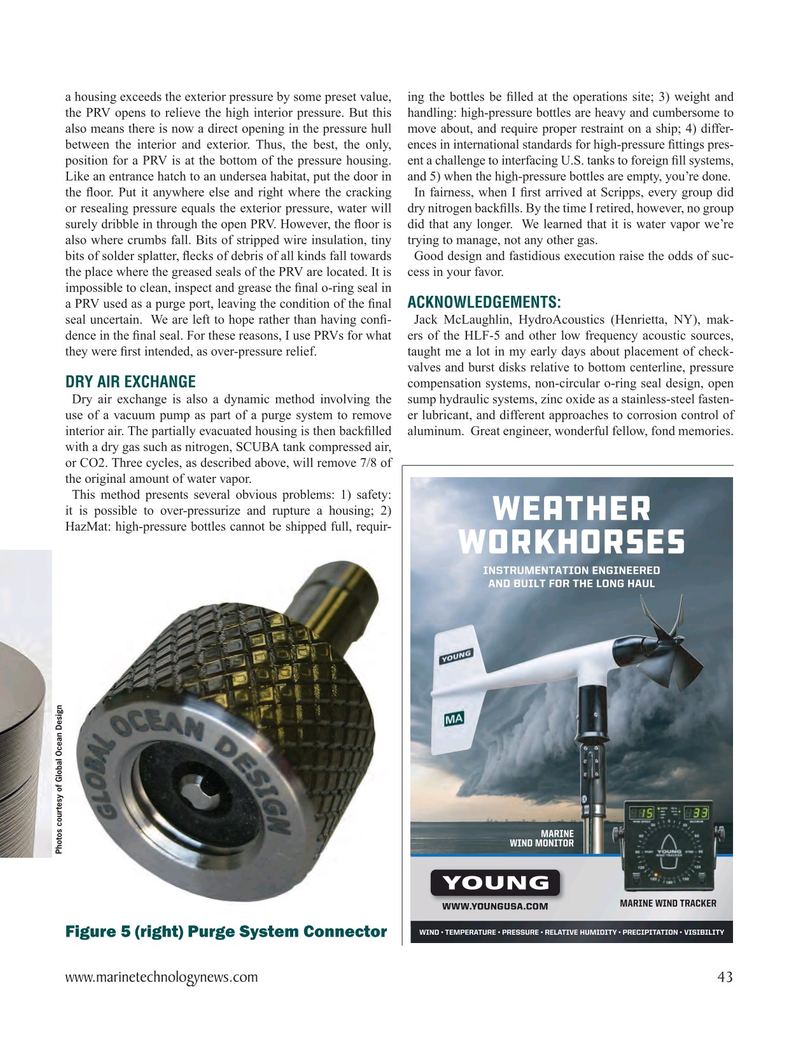
Page 43: of Marine Technology Magazine (March 2023)
Read this page in Pdf, Flash or Html5 edition of March 2023 Marine Technology Magazine
a housing exceeds the exterior pressure by some preset value, ing the bottles be ? lled at the operations site; 3) weight and the PRV opens to relieve the high interior pressure. But this handling: high-pressure bottles are heavy and cumbersome to also means there is now a direct opening in the pressure hull move about, and require proper restraint on a ship; 4) differ- between the interior and exterior. Thus, the best, the only, ences in international standards for high-pressure ? ttings pres- position for a PRV is at the bottom of the pressure housing. ent a challenge to interfacing U.S. tanks to foreign ? ll systems,
Like an entrance hatch to an undersea habitat, put the door in and 5) when the high-pressure bottles are empty, you’re done.
the ? oor. Put it anywhere else and right where the cracking In fairness, when I ? rst arrived at Scripps, every group did or resealing pressure equals the exterior pressure, water will dry nitrogen back? lls. By the time I retired, however, no group surely dribble in through the open PRV. However, the ? oor is did that any longer. We learned that it is water vapor we’re also where crumbs fall. Bits of stripped wire insulation, tiny trying to manage, not any other gas.
bits of solder splatter, ? ecks of debris of all kinds fall towards Good design and fastidious execution raise the odds of suc- the place where the greased seals of the PRV are located. It is cess in your favor. impossible to clean, inspect and grease the ? nal o-ring seal in a PRV used as a purge port, leaving the condition of the ? nal
ACKNOWLEDGEMENTS: seal uncertain. We are left to hope rather than having con? - Jack McLaughlin, HydroAcoustics (Henrietta, NY), mak- dence in the ? nal seal. For these reasons, I use PRVs for what ers of the HLF-5 and other low frequency acoustic sources, they were ? rst intended, as over-pressure relief. taught me a lot in my early days about placement of check- valves and burst disks relative to bottom centerline, pressure compensation systems, non-circular o-ring seal design, open
DRY AIR EXCHANGE
Dry air exchange is also a dynamic method involving the sump hydraulic systems, zinc oxide as a stainless-steel fasten- use of a vacuum pump as part of a purge system to remove er lubricant, and different approaches to corrosion control of interior air. The partially evacuated housing is then back? lled aluminum. Great engineer, wonderful fellow, fond memories.
with a dry gas such as nitrogen, SCUBA tank compressed air, or CO2. Three cycles, as described above, will remove 7/8 of the original amount of water vapor.
This method presents several obvious problems: 1) safety: it is possible to over-pressurize and rupture a housing; 2)
HazMat: high-pressure bottles cannot be shipped full, requir-
Photos courtesy of Global Ocean Design
Figure 5 (right) Purge System Connector www.marinetechnologynews.com 43
MTR #3 (34-49).indd 43 3/19/2023 7:51:40 PM

 42
42

 44
44
